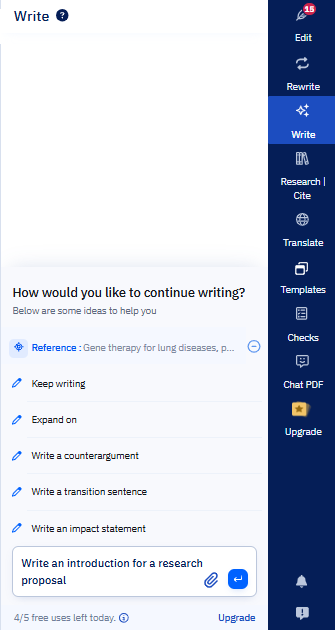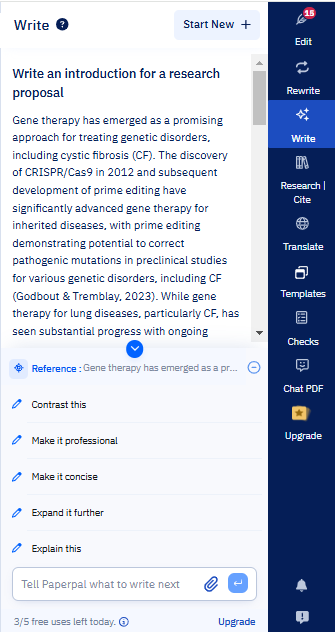Table of Contents
Before conducting a study, a research proposal should be created that outlines researchers’ plans and methodology and is submitted to the concerned evaluating organization or person. Creating a research proposal is an important step to ensure that researchers are on track and are moving forward as intended. A research proposal sample can be defined as a detailed plan or blueprint for the proposed research that you intend to undertake. It provides readers with a snapshot of your project by describing what you will investigate, why it is needed, and how you will conduct the research.
Your research proposal should aim to explain to the readers why your research is relevant and original, that you understand the context and current scenario in the field, have the appropriate resources to conduct the research, and that the research is feasible given the usual constraints.
This article will describe in detail the purpose and typical research proposal structure, along with research proposal example for students to help you ace this step in your research journey.
What is a Research Proposal?
A research proposal¹,² can be defined as a formal report that describes your proposed research, its objectives, methodology, implications, and other important details. Research proposal format is the framework of your research and is used to obtain approvals or grants to conduct the study from various committees or organizations. Consequently, research proposals should convince readers of your study’s credibility, accuracy, achievability, practicality, and reproducibility.
With research proposals, researchers usually aim to persuade the readers, funding agencies, educational institutions, and supervisors to approve the proposal. To achieve this, the report should be well structured with the objectives written in clear, understandable language devoid of jargon. A well-organized research proposal conveys to the readers or evaluators that the writer has thought out the research plan meticulously and has the resources to ensure timely completion.
Learn How to Write a Research Proposal with Paperpal
Purpose of Research Proposals
A research proposal is a sales pitch and therefore should be detailed enough to convince your readers, who could be supervisors, ethics committees, universities, etc., that what you’re proposing has merit and is feasible. Research proposals can help students discuss their dissertation with their faculty or fulfill course requirements and also help researchers obtain funding. A well-structured proposal instills confidence among readers about your ability to conduct and complete the study as proposed.
Research proposals can be written for several reasons:³
- To describe the importance of research in the specific topic
- Address any potential challenges you may encounter
- Showcase knowledge in the field and your ability to conduct a study
- Apply for a role at a research institute
- Convince a research supervisor or university that your research can satisfy the requirements of a degree program
- Highlight the importance of your research to organizations that may sponsor your project
- Identify implications of your project and how it can benefit the audience
What Goes in a Research Proposal?
Research proposals should aim to answer the three basic questions—what, why, and how.
The What question should be answered by describing the specific subject being researched. It should typically include the objectives, the cohort details, and the location or setting.
The Why question should be answered by describing the existing scenario of the subject, listing unanswered questions, identifying gaps in the existing research, and describing how your study can address these gaps, along with the implications and significance.
The How question should be answered by describing the proposed research methodology, data analysis tools expected to be used, and other details to describe your proposed methodology.
These questions form the foundation of any effective research proposal structure and guide the logical flow of the document.
Research Proposal Example
Here is a research proposal example template from the University of Rochester Medical Center.[4] The sections in all research proposals are essentially the same although different terminology and other specific sections may be used depending on the subject.
Structure of a Research Proposal
If you want to know how to write a research proposal that is impactful, include the following components:¹
1. Introduction
This section provides a background of the study, including the research topic, what is already known about it and the gaps, and the significance of the proposed research.
Want to write a strong introduction for your research proposal? Upload your rough notes to Paperpal. Then, use Paperpal’s “Write” feature to create an introduction based on those notes. You can even give Paperpal specific instructions about what you want the introduction to cover, so the results are tailored just for you.
For example, if you want to write an introduction for a research proposal with Paperpal Write, you can either upload your notes or just paste it on the web editor.
Paperpal uses your notes as a reference to generate the introduction for your research proposal. You can customize instructions about the points to cover and more to get tailored results.
- Prompt Paperpal to Write
- Customize results as you want
2. Literature review
This section contains descriptions of all the previous relevant studies pertaining to the research topic. Every study cited should be described in a few sentences, starting with the general studies to the more specific ones. This section builds on the understanding gained by readers in the Introduction section and supports it by citing relevant prior literature, indicating to readers that you have thoroughly researched your subject.
Do not miss reading: How to Write a Literature Review with Paperpal: Step-by-Step Guide
3. Objectives
Once the background and gaps in the research topic have been established, authors must now state the aims of the research clearly. Hypotheses should be mentioned here. This section further helps readers understand what your study’s specific goals are.
4. Research design and methodology
Here, authors should clearly describe the methods they intend to use to achieve their proposed objectives. Important components of this section include the population and sample size, data collection and analysis methods and duration, statistical analysis software, measures to avoid bias (randomization, blinding), etc.
5. Ethical considerations
This refers to the protection of participants’ rights, such as the right to privacy, right to confidentiality, etc. Researchers need to obtain informed consent and institutional review approval by the required authorities and mention this clearly for transparency.
6. Budget/funding
Researchers should prepare their budget and include all expected expenditures. An additional allowance for contingencies such as delays should also be factored in.
7. Appendices
This section typically includes information that supports the research proposal and may include informed consent forms, questionnaires, participant information, measurement tools, etc.
8. Citations
Always ensure to cite all sources referred to while writing the proposal. Any citation method could be used as long as it is consistent and adheres to a specific format. Always check an example of research proposal from your department to ensure your references follow the expected format.
Important Tips for Writing a Research Proposal
Writing a research proposal begins much before the actual task of writing. Planning the format of research proposal structure and content is an important stage, which if done efficiently, can help you seamlessly transition into the writing stage.3,5
The Planning Stage
- Manage your time efficiently. Plan to have the draft version ready at least two weeks before your deadline and the final version at least two to three days before the deadline.
- Plan out your proposed content. See if you have answers to a few important questions, as follows, and if not, search for them.
- What is the primary objective of your research?
- Will your research address any existing gap?
- What is the impact of your proposed research?
- Do people outside your field find your research applicable in other areas?
- If your research is unsuccessful, would there still be other useful research outcomes?
The Writing Stage
- Create an outline with main section headings that are typically used.
- Focus only on writing and getting your points across without worrying about the format of the research proposal, grammar, punctuation, etc. These can be fixed during the subsequent passes. Add details to each section heading you created in the beginning.
- Ensure your sentences are concise and use plain language. A research proposal usually contains about 2,000 to 4,000 words or four to seven pages.
- Don’t use too many technical terms and abbreviations assuming that the readers would know them. Define the abbreviations and technical terms.
- Ensure that the entire content is readable. Avoid using long paragraphs because they affect the continuity in reading. Break them into shorter paragraphs and introduce some white space for readability.
- Focus on only the major research issues and cite sources accordingly. Don’t include generic information or their sources in the literature review.
- Proofread your final document to ensure there are no grammatical errors so readers can enjoy a seamless, uninterrupted read.
- Use academic, scholarly language because it brings formality into a document.
- Ensure that your title is created using the keywords in the document and is neither too long and specific nor too short and general.
- Cite all sources appropriately to avoid plagiarism.
- Make sure that you follow guidelines, if provided. This includes rules as simple as using a specific font or a hyphen or en dash between numerical ranges.
- Ensure that you’ve answered all questions requested by the evaluating authority.
Key Takeaways
Here’s a summary of the main points about research proposals discussed in the previous sections:
- A research proposal is a document that outlines the details of a proposed study and is created by researchers to submit to evaluators who could be research institutions, universities, faculty, etc.
- Research proposals are usually about 2,000-4,000 words long, but this depends on the evaluating authority’s guidelines.
- A good research proposal ensures that you’ve done your background research and assessed the feasibility of the research.
- Research proposals have the following main sections—introduction, literature review, objectives, methodology, ethical considerations, and budget.
Frequently Asked Questions
References
- Sudheesh K, Duggappa DR, Nethra SS. How to write a research proposal? Indian J Anaesth. 2016;60(9):631-634. Accessed July 15, 2024. https://www.ncbi.nlm.nih.gov/pmc/articles/PMC5037942/
- Writing research proposals. Harvard College Office of Undergraduate Research and Fellowships. Harvard University. Accessed July 14, 2024. https://uraf.harvard.edu/apply-opportunities/app-components/essays/research-proposals
- What is a research proposal? Plus how to write one. Indeed website. Accessed July 17, 2024. https://www.indeed.com/career-advice/career-development/research-proposal
- Research proposal template. University of Rochester Medical Center. Accessed July 16, 2024. https://www.urmc.rochester.edu/MediaLibraries/URMCMedia/pediatrics/research/documents/Research-proposal-Template.pdf
- Tips for successful proposal writing. Johns Hopkins University. Accessed July 17, 2024. https://research.jhu.edu/wp-content/uploads/2018/09/Tips-for-Successful-Proposal-Writing.pdf
- Formal review of research proposals. Cornell University. Accessed July 18, 2024. https://irp.dpb.cornell.edu/surveys/survey-assessment-review-group/research-proposals
- 7 Mistakes you must avoid in your research proposal. Aveksana (via LinkedIn). Accessed July 17, 2024. https://www.linkedin.com/pulse/7-mistakes-you-must-avoid-your-research-proposal-aveksana-cmtwf/
Paperpal is a comprehensive AI writing toolkit that helps students and researchers achieve 2x the writing in half the time. It leverages 22+ years of STM experience and insights from millions of research articles to provide in-depth academic writing, language editing, and submission readiness support to help you write better, faster.
Get accurate academic translations, rewriting support, grammar checks, vocabulary suggestions, and generative AI assistance that delivers human precision at machine speed. Try for free or upgrade to Paperpal Prime starting at US$25 a month to access premium features, including consistency, plagiarism, and 30+ submission readiness checks to help you succeed.
Experience the future of academic writing – Sign up to Paperpal and start writing for free!








